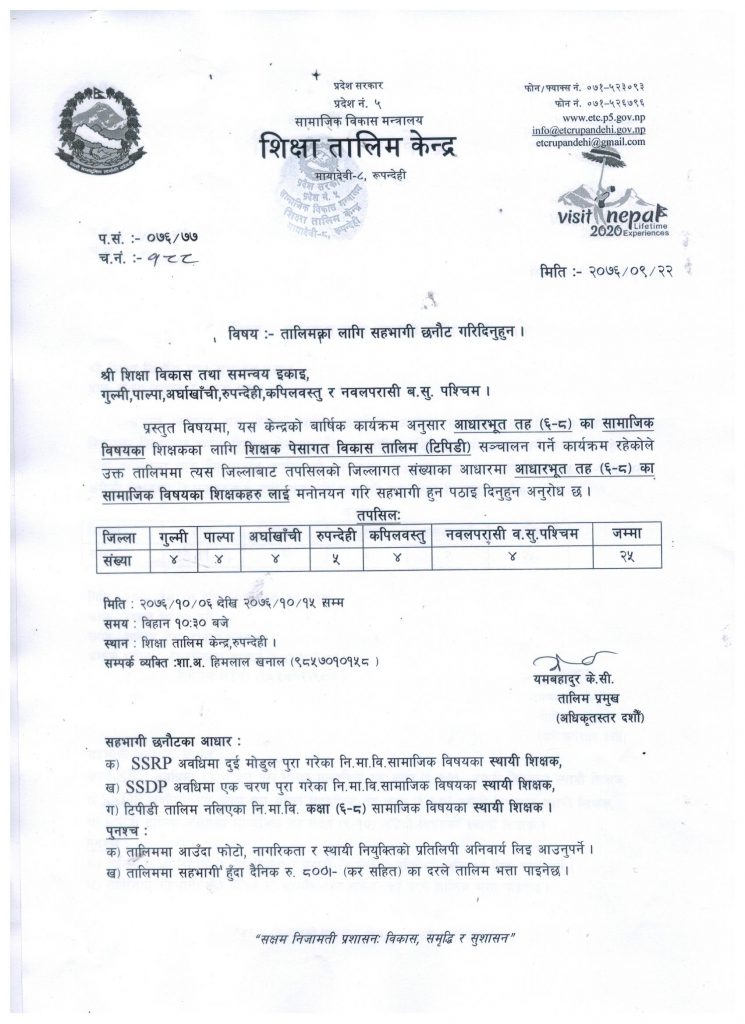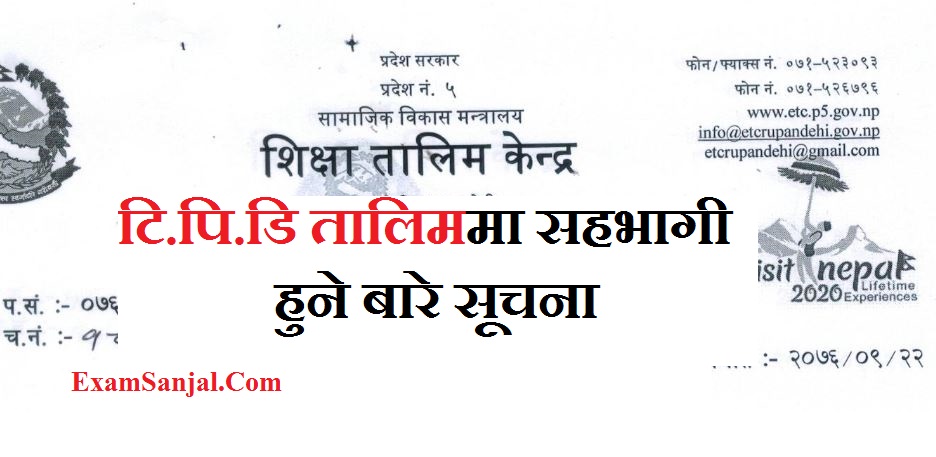Education Training Center, Province 5 Bhairahawa published notice regarding Teacher training- Teachers’ professional Development. All information about teacher training are given below. TPD taalim notice are given below.


Teacher education is made up of two words- ‘teacher’ and ‘education’. A teacher is a person who teaches the learners or students and makes them acquire knowledge, skills, and attitudes. In a different way, a teacher is a person who facilitates the learners for learning and co-operates with their problems to get them solved which results in the all- round development of the learners. Education is the process of gaining knowledge and wisdom. Thus the collaboration of these two words suggests us the education for the teacher as teacher education. So the process of gaining knowledge and skills for teachers is teacher education.
Teacher education involves the whole process of producing teachers. Teacher education has two broad aspects: theoretical and practical. The theoretical aspect is concerned with collective theoretical knowledge of the profession. It is also concerned with the personal philosophy that a teacher preserves in his/her mind, and that guides his/her teaching behavior. Both of these theoretical aspects set the foundation for teaching. The practical skills and activities are also essential. In teacher education, the teachers involved in model teaching which helps them to gain practical skills which they can use in the real teaching. Teacher education has a broad scope ranging from curricular contents, professional strategies and theoretical frameworks to actions, research, activities and reflective practices. It also includes two aspects- teacher training and teacher development. It initiates from the period of recruitment to the retirement from the teaching-learning process.
Teacher Training
Teacher training encompasses two aspects – preparing teaches about “the content” and “the methodology”. This is to say, the process of preparing teacher about content i.e. ‘what aspect’ and the methodology i.e. ‘how aspect’ is teacher training. It can be pre-service teacher training in which teachers are given adequate training before they enter the field of teaching. The persons who are interested in teaching are involved in this training. They learn different theories, methods, and techniques which are to be used while teaching. They also learn about child development, child psychology, curriculum and objectives which are useful for them for teaching. However, pre-service training alone is not sufficient to produce competent and confident teachers. They may not be provided with everything they need to know. In complement, to pre-service training, another type of training is required which is in-service training. They should be trained from time to time after they enter the real field. As time passes, there are changes in every field along with the educational field. Truth, knowledge, technologies keep on changing. There is the need for in-service training in order to keep the teachers up to date.
Steps of Training
Training plays a vital role in effective teaching. It helps to set the educational plans. It helps to update about the recent technologies and devices which can be used for the teaching-learning activities. It is useful for designing and preparing teaching aids and strategies. The teachers can find out the appropriate teaching methods to teach the students in a child-friendly environment. It is essential for the teachers to acquire knowledge about the objectives, teaching methods, and evaluation system. Thus such an important task should be conducted in a systematic way.
Voices on-the-ground : We cannot deny the contribution of teacher training to teachers’ professional development. It plays a prominent role in teacher professional development. But, the teachers on-the-ground usually perceive that teacher training and teacher professional development program are synonymous. They think that TPD is the continuation of the previous training programs. This kind of belief system of the teachers, head teachers and PTAs and SMCs create a big gap between the 98.2% data of the trained teachers from community-based schools (NCED-2066) and teachers’ demands about the what ‘aspect’ and how ‘aspect’ of their teaching in the TPD program. I find a significant gap between the expectations of the policy makers and teachers. It is, therefore, necessary to make teachers clear about the difference between training and professional development. Here, I don’t mean to say that training does not have any role for the teachers’ professional development and empowering them. As mentioned above, to a large extent, it facilitates to enhance teachers’ professional development, but the activities and the way they have to be performed in these two areas of teacher education differ largely. Head and Taylor (1997, p. 5) have presented following differences between teacher training and teacher development:

